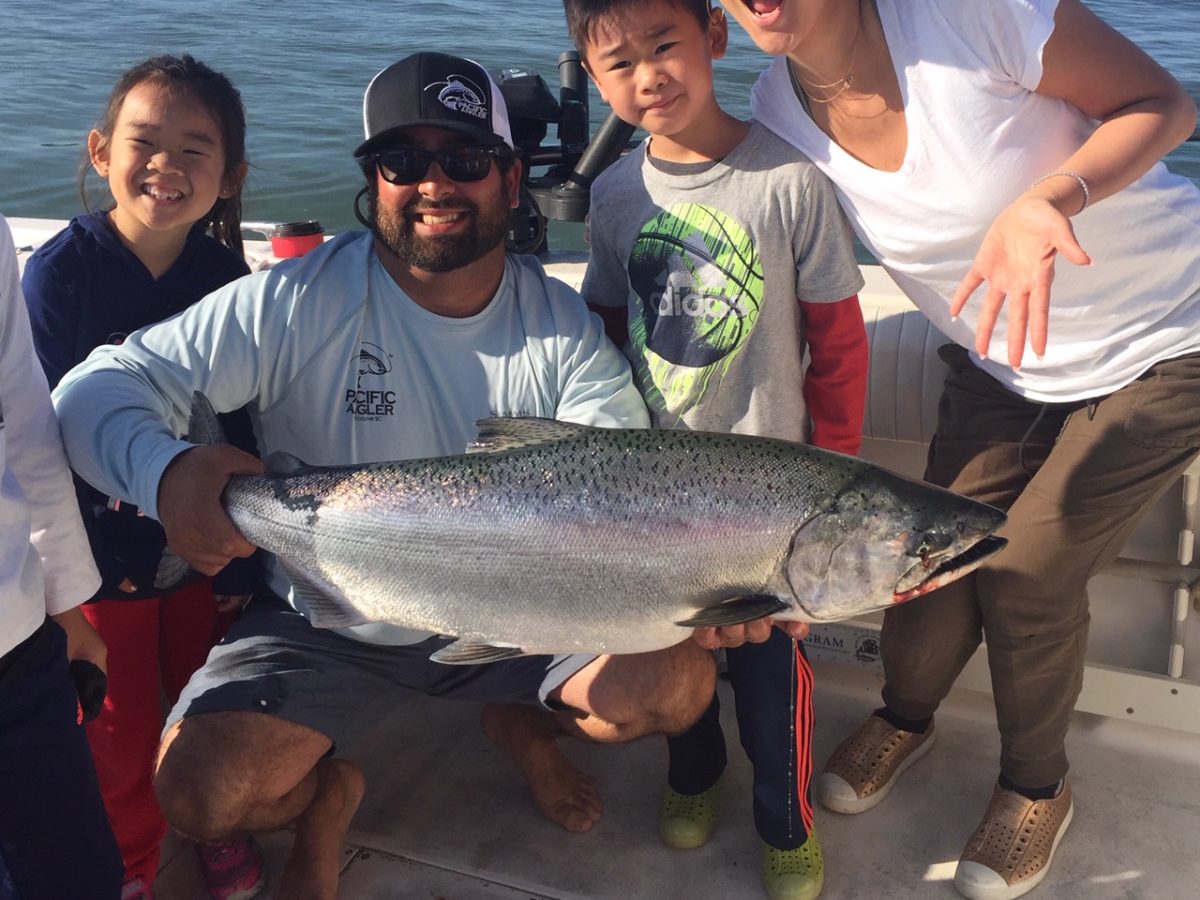OUTLOOK
Well August is here, with the Fraser Panel report and new tidal fishing regulations fresh off the press, a bunch of fisheries are fishing really well, and others are facing some concerns, there is a lot going on.
Let’s start with the regulation changes. As of August 1st, the slot limit on chinook is over. So, one fish over 62cm is legal to retain. Good news! We still say that there is nothing cooler than releasing a very large fish and seeing it swim away to make more big fish but at least for the 15-25 lb fish we are now able to bring one home. After August 30th we will be back to two a day. They have also opened 29-1, 29-2, 29-3 (South of Bowen) and 29-4 for one chinook a day over 62cm. Check out the official notice here. There are a variety of amendments/clarifications posted in the last 24 hours so be sure to review those. All notices are easily found on this page.
The chinook fishing in the salt continues to be great. We have seen more fish and bigger fish this year. We also have a special edition report from the sunshine coast this week. Brendan had a super successful trip and if you are heading that way the fishing is very good right now.
On the local front Jason is off at the Dean this week, so Derek is going to take over the SW report. The long and short of it is we are seeing good numbers of Pinks around the corner up Howe Sound and around Bowen. In the harbour, the Bell has been producing very consistent chinook.
Outside of the regulation changes, one of the big questions we are getting asked is about the pink salmon. Yes, they have shown up. We had reports yesterday of pinks in Squamish and for about a week the guides have been getting good numbers in Howe Sound trolling and casting.
I have been looking at fisheries reports on the Fraser Pinks. You have to be a biologist to really understand the information. You will hear talk of P50 numbers. This is the number that fits the middle of their bell curve. Meaning there is a 50% chance it could be better and a 50% chance it could be worse. It sounds kind of like a game of roulette at the casino but if you look at 10-20 years of data the trends seem to come close to the P50 most years.
The P50 for Sockeye on Fraser is 4.7 million. This is average for this cycle, but this cycle is not known for having openings, so it is not bad news, but we probably won’t have an opening. For the Pinks we are seeing a P50 that is better than the last cycle but way below the average of 12 million fish. This is Ok news, but it isn’t great. We should see some good pink fishing, but it will not be consistent. They do not have solid numbers for the Howe Sound Pinks but in past years the Squamish fish have mirrored the Fraser fish with a level of consistency.
So that’s what the DFO scientists are saying. Let’s compare it to fisherman’s science. What we have been seeing on the water. When I look at our logs, good fishing on beaches up Howe Sound started 4 weeks ago in 2015. This was an amazing year. When we look at last year, we saw some “ok” reports this week, but we never really had the concentration of fish to make beach fishing consistent. So at least from our 12-14 years of information the numbers from DFO make sense.
Long story short it is time to go pink fishing up Howe Sound but with lower numbers, beach fishing consistency is not going to be great. On the Squamish, guys and girls who know what they are doing are getting fish. There have even been some epic days but don’t expect epic days every day. So get out there, put time on the water and it should be worth the trip. Alex has more details below and we can only hope for more epic days to come.
If you want to fish the Seymour mouth or up Indian Arm for pinks, we expect them soon but have not heard anything yet. When we hear the first reports of pinks off the Capilano mouth we know it is getting close. The Fraser should be a few weeks out yet.
On the trout fishing front, this is a great time to hit trout rivers in the interior. The Skagit, Thompson, and all the interior rivers are doing well. We have some low water concerns, but they are not at a critical stage yet. We have staff out on the water over the weekend. We have intel in the blog below and more intel will be coming soon.
The Vedder has also been a fishery worth looking at. We have heard of solid number of chinook. The early component of this fishery is like steelheading / minus the cold weather. You don’t expect to catch a ton if any on an outing and you need to put in your time. That said it is worth hitting the water for and numbers will ramp up as we get into August. Alex has more details in our blog report.
Last but not least, Zach has a very cool article of fly-tying thread. Never thought I would call an article on thread cool, but he walks you through the differences and how you can use different threads to achieve different results. This is a common mistake we see in even intermediate tier’s patterns. For more details check it all out below.
We hope you all enjoy the long weekend – we’ll be in the shop regular hours Friday, Saturday and Sunday and closed on Monday to enjoy BC Day on the water
BC Day Long Weekend Hours
Friday August 2 | 10AM – 7PM
Saturday August 3 | 10AM – 6PM
Sunday August 4 | 11AM – 5PM
Monday August 5 | Closed – we’ll see you on the water!
INDUSTRY EVENTS + UPDATES
Trout School
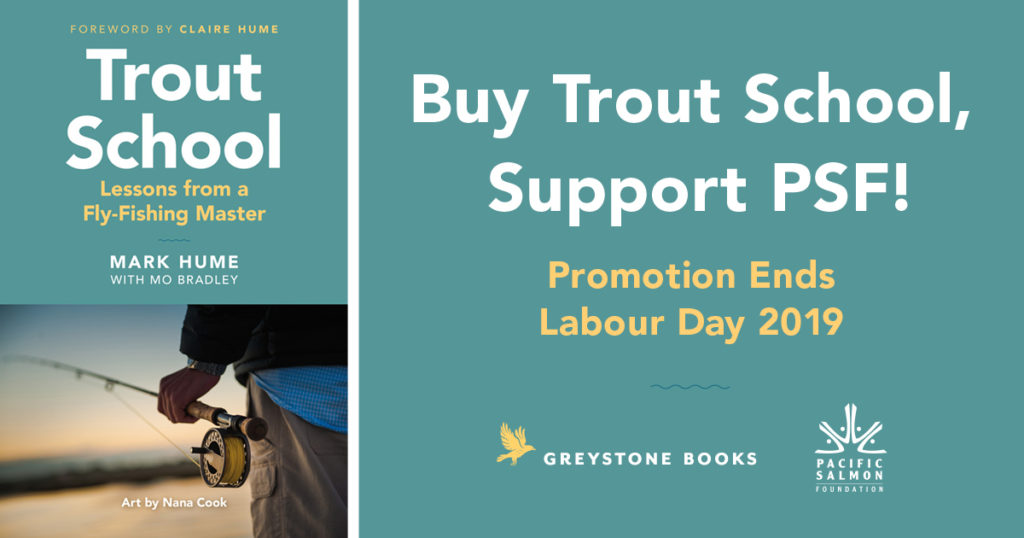
| A win-win for you and salmon! |
| We’re excited to share a special offer that is being made available to friends of the Pacific Salmon Foundation From now until labour day, when you enter the promo code “PSF” at purchase on the Greystone website here you will receive 10% off the price of Trout School by Mark Hume and Greystone Books will donate $2 from every sale to the Pacific Salmon Foundation. Buy Trout School now. About Trout School Trout School is the newest book from awarding winning environmental journalist and author Mark Hume. Among fly fishers, the Kamloops region in British Columbia’s Thompson-Okanagan is known as one of the best places in the world for catching trout. It owes its reputation in part to Mo Bradley, a man of humble origins now known as a pioneer of fly-fishing culture. In Trout School, Mark Hume passes on what he’s learned from his countless hours on—and off—the lake with the master. Drawing from more than twenty years of fishing and friendship, Hume distills the best of Mo’s essential knowledge, including tips and tricks for catching Kamloops trout year-round, detailed instructions for tying thirteen signature flies, and advice for a more respectful and ecologically conscious approach to fishing. Read more. |
CLASSES + COURSES
Have you signed up for our Introduction to Fly Fishing Course yet? Call the shop at 604.872.2204 to sign up today!
Introduction To Fly Fishing
This course was specifically designed to give the new fly fisher the basic knowledge, casting skills and fly fishing strategies to effectively fish our local BC waters. This course is comprised of two sessions; 3hr evening seminar and a 3hr casting session.
Cost: $150.00
Dates: Seminar Aug 20th & Casting Aug 25th
Seminar Time: 6:30pm – 9:30pm
Casting Time(s): 10am – 1pm or 1:30pm -4:30pm
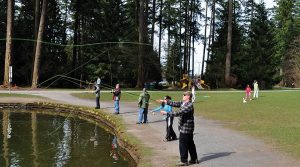
FLY TYING PRODUCT FEATURE
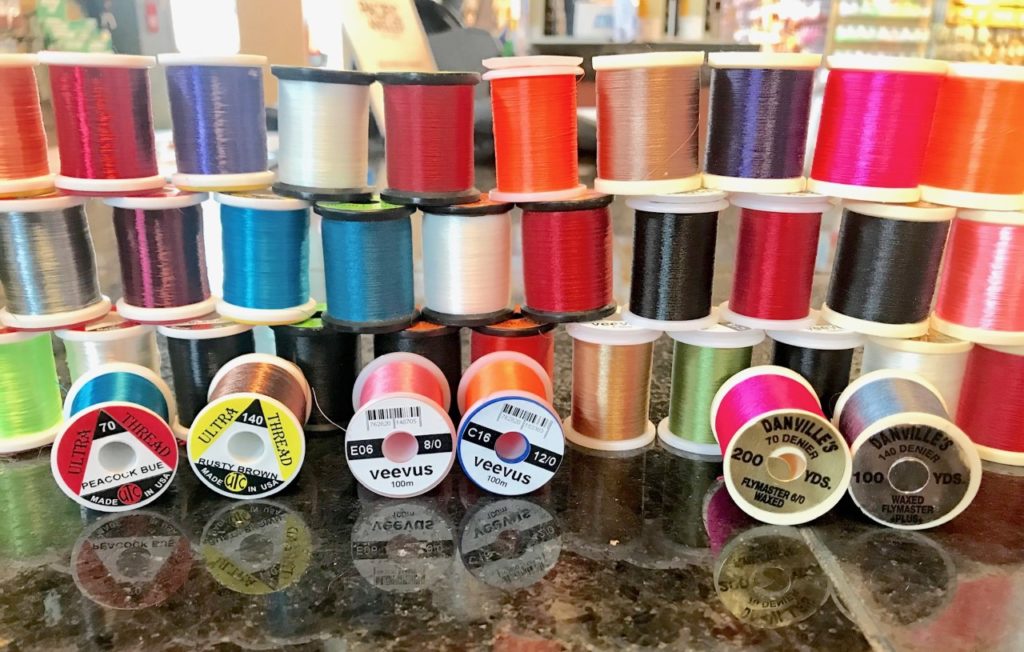
One of the most misunderstood fly tying materials that we have in the shop may surprise you, that material is thread. We get asked a lot in the shop about what the differences are between all the threads that we have on our thread rack. They may all look the same but in reality, they are all quite different and knowing the subtleties between them and when to use one thread over another can make you either love a certain tying thread or hate it. My goal in this piece is to help you understand thread a bit more and hopefully answer some of the questions that you have wanted to ask but for whatever reason haven’t.
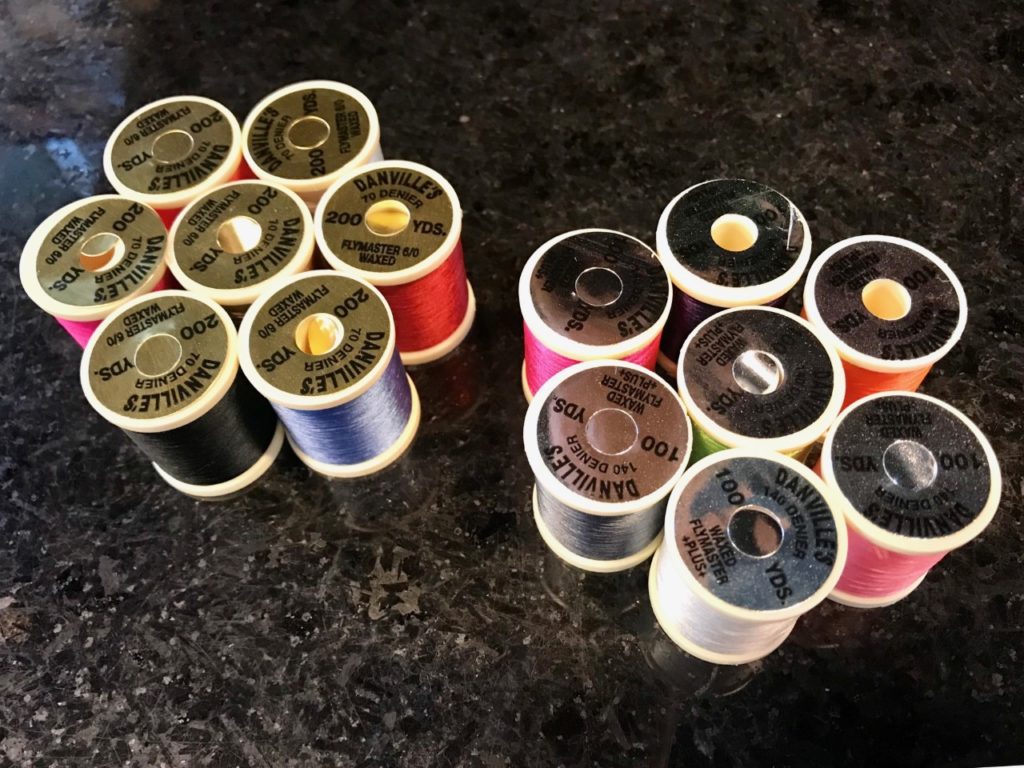
Thread Rating:
The biggest issue with thread for most people is understanding the numbering systems. There are 2 different systems and they couldn’t be any more opposite if they tried to be, this is where a lot of the confusion with thread comes in. The most trustworthy rating and the one that I like to use personally (when available) is the Denier rating.
What is Denier? At its most basic definition, Denier is the thickness of a weave of nylon, silk, thread, etc. Basically, the bigger the Denier number rating the thicker the thread. For example a 70 Denier thread is thinner than a 140 Denier thread. I like to use 70 denier for my stillwater and nymph patterns, whereas I like a 140 for my streamers and intruder patterns.
It would be amazing if this was the only rating system available for thread, unfortunately there is also an “ought” system which is the complete opposite from a Denier rating. The “ought” rating looks similar to your larger hook sizes: 8/0, 6/0, 3/0 are examples of what these thread ratings will look like. Unlike a Denier rating, the Ought ratings get thicker with a smaller number; for example a 8/0 thread is thinner than a 6/0 thread. Denier is harder to find variances between brands, which is nice as a denier rating for thread is an actual unit of measurement, you will find very little variances between a UTC 70 Denier and a Danville 70 Denier thread when it comes to thickness. The Ought system seems to be proprietary to each brand. One companies 8/0 will be totally different from another companies 8/0. This is why I prefer the Denier system of ratings because I know roughly how thick each thread from different brands will be. If you want a general rule for comparison between the rating systems, generally a 70 Denier thread is very similar to a 8/0 thread in thickness. A 140 Denier is very similar to a 6/0 thread. Once you wrap your head around the rating systems you should be home free for the most part when choosing threads for certain fly patterns.
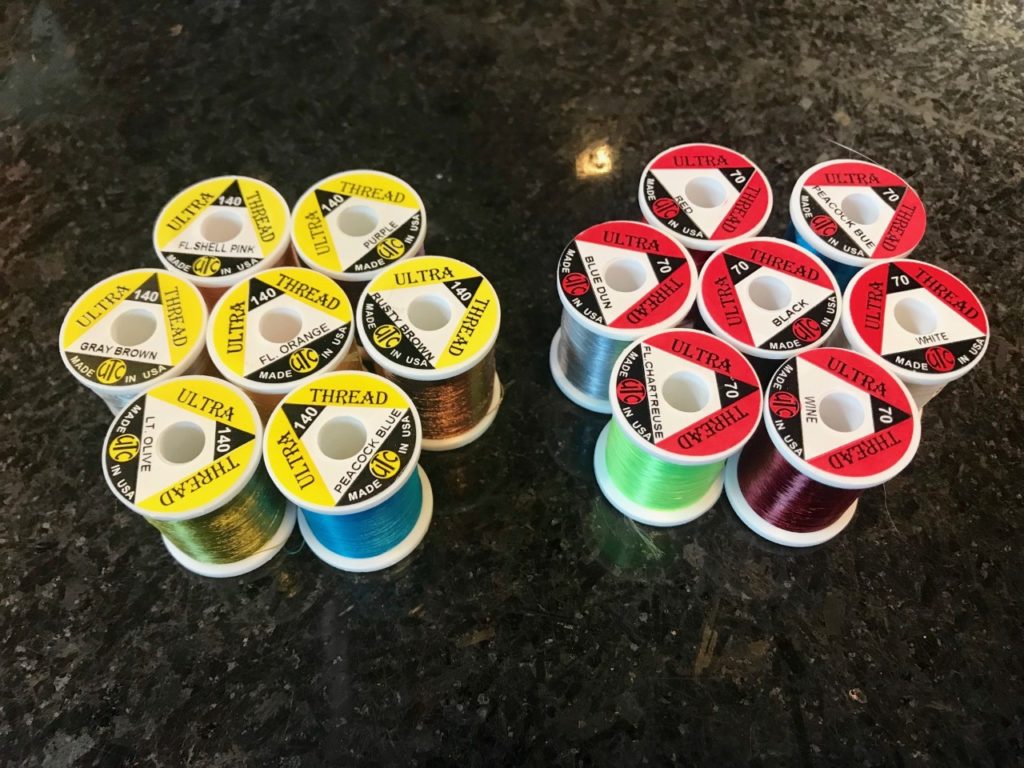
Brands:
There are a lot of new brands of thread out there but the 3 brands that are the most consistent for quality and that have been around forever are UTC, Danville and UNI. There are subtle differences between these 3 and there are some reasons while I like one thread vs another for certain tying applications. I like UTC because it can lay really flat when it is spun counterclockwise. This is great for tying chironomids and other nymphs where you need a smooth body. UTC also comes in just about every color known to man. The one thing that at times I see as a drawback with UTC is that the colours have a bit too much shine to them, sometimes I like it, other times I don’t.
Danville is one of my favourite threads. It can still lay flat but isn’t quite as flat as UTC, it comes in a large variety of colours and it is quite strong for its thickness as well. The one thing that sets Danville apart from UTC for me is that the colours are more subdued, meaning they have a more natural sheen and colour tone to them and don’t shine quite as much.
Uni is one of those threads that has been around forever. They have a descent colour selection but it doesn’t lay flat. Veevus is a newer thread that we have started to fall in love with as well. It is very similar to UNI in that it doesn’t lay flat, also, the colour selection isn’t as good as UNI but it is getting better all the time. Where Veevus really shines is in its strength. a 12/0 Veevus is comparable to most 70 Denier or 8/0 versions of thread for strength which is pretty crazy considering how thin it is.
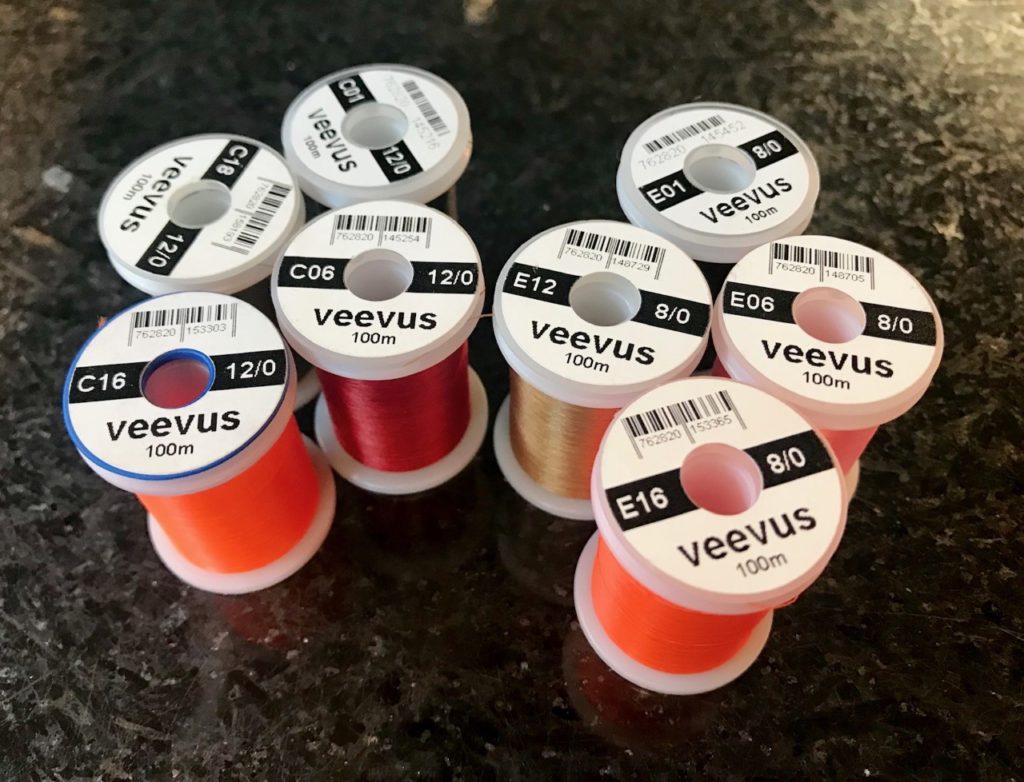
I tie with every thread out there and I like them all for different reasons. This is just a general overview of threads and we could really geek out on this topic and really split threads but I didn’t want to get too crazy into it in this article. I hope this answers some of the questions that you might have about threads and it is very important to know the differences between all of them. They all have their time and place and playing around with them is the easiest way to learn about what each thread excels at and what their limitations are. The best part about experimenting with thread is that it is cheap so you can afford to experiment with it unlike with other materials that can cost a small fortune. If you have any other questions please don’t hesitate to come on in to the shop and we will be more than happy to help you out with any of your tying questions!
FRESHWATER FISHING REPORTS
Squamish River Fishing Report
I am not normally tasked with writing the coveted Squamish report but, as one of the guys at the Shop that loves to partake in the pink salmon festivities on the Squamish every two years, I have been keeping a close eye on this fishery and have gotten out a couple of times looking for Humpies. Thus, I have a relatively up to date report for all our readers. I know a lot of you are chomping at the bit to hear how the numbers are in the river, so I will give it to you straight. Here is the truth with no exaggerations or sugar-coating!
There are fish in the system now and the fishing has been ranging from below average to decent. It’s a vague answer for sure, but fishing success has been very contingent on timing. To put it simply, if you are there when the fish are pushing through, the fishing can be quite good. However, there are also long dead periods in-between these waves of fish, so depending on who you ask (and when they were there) you will get responses on both sides of the spectrum. There are fish moving through all day long but to increase your chance at having a banner day you will want to time your trip to be two hours before and after high tide. While first light is also nice, a big school of Pinks riding the tide will trump the higher light conditions later in the day and you can have some stellar fishing after you’ve had lunch.
So what has been working? The fly fishers have been doing well swinging and dangling small pink streamers. For the gear chuckers pink spoons, spinners, and twitching jigs have been picking up fish. I normally like to mix it up a bit and throw some chartreuse presentations as well although I have to admit that on my last trip I couldn’t buy a bite on anything except for stuff that was bright pink!
If you want to time it for when the fishing is easy, I would wait another week or two. There are enough fish now to get them but to reiterate, you want to be there during the optimal tide or else it is still a bit of a grind.
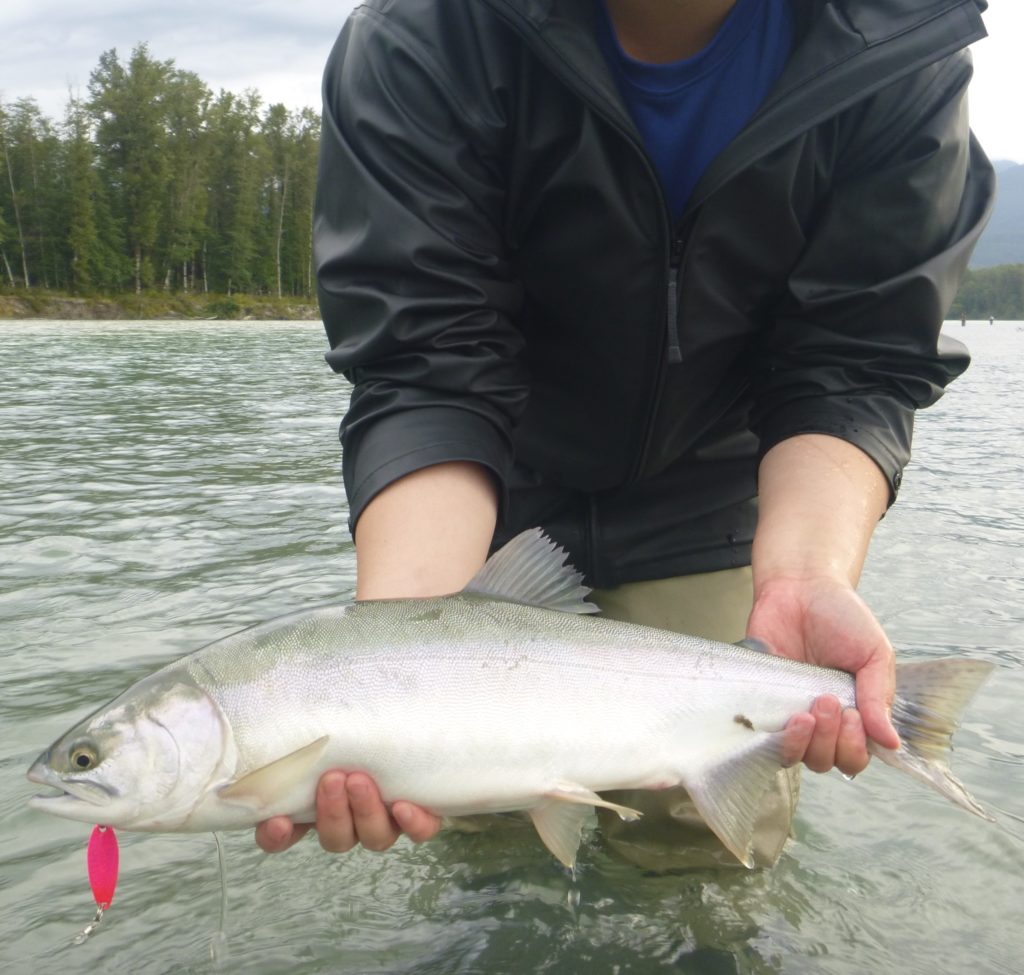
Chilliwack/Vedder River Fishing Report
Red chinook fishing continues to be good on the Chilliwack River. It is still a tough fishery at the best of times, but we’ve had a number of anglers reporting of a hook up or two in the mornings. The river is on the lower side and pretty clear, so don’t be afraid to downsize your presentations. Pro-cured roe, jensen eggs, beads, colorado blades, and wool ties have been effective. Chartreuse, blue, or black intruders on heavy sink tips can draw grabs on the fly rod as well. Focus on the deep pools and, with the water conditions now, I would look towards the mid or head of the pool as they will feel most comfortable resting in these deeper sections. Get out there early too as there is a window between first light and 9-10am when the bite can be on, but afterwards they tend to shut off and are difficult to convince.
There are also a number of Sockeye Salmon in the system. Please familiarize yourself with how to identify these fish as they are strictly catch and release. They can be a fun fight but please treat any you do hook with care and release them promptly.
Alex Au-Yeung
Skagit River Fishing Report
The Skagit has definitely dropped a considerable amount since the last time I was up a week ago. It is now a very accessible water level for all anglers. With the lower water, covering ground is now key. Getting away from the standard pullouts and walking either up or down river to untouched water will produce more fish as the season progresses. On the fishing side, rainbow trout fishing continues to be excellent. Nymphing in the morning with your standard prince nymphs or girdle bugs as well as a wider bodied mayfly imitation under an indicator will get you into a few fish. As the day progresses, we are starting to see a more noticeable hatch in the afternoon with the warmer and more consistent temperatures.
Having your box stocked with a variety of mayfly imitations is key. I generally carry two larger style patterns (sz 8-10) like a grey wulff or extended body mayfly. In addition, my box has a variety of smaller parachute-style patterns in sizes 12-16. Both greys and green will work, however, the majority of the mayflies are typically grey this time of year. We tend to see the larger green drakes later into mid-august.
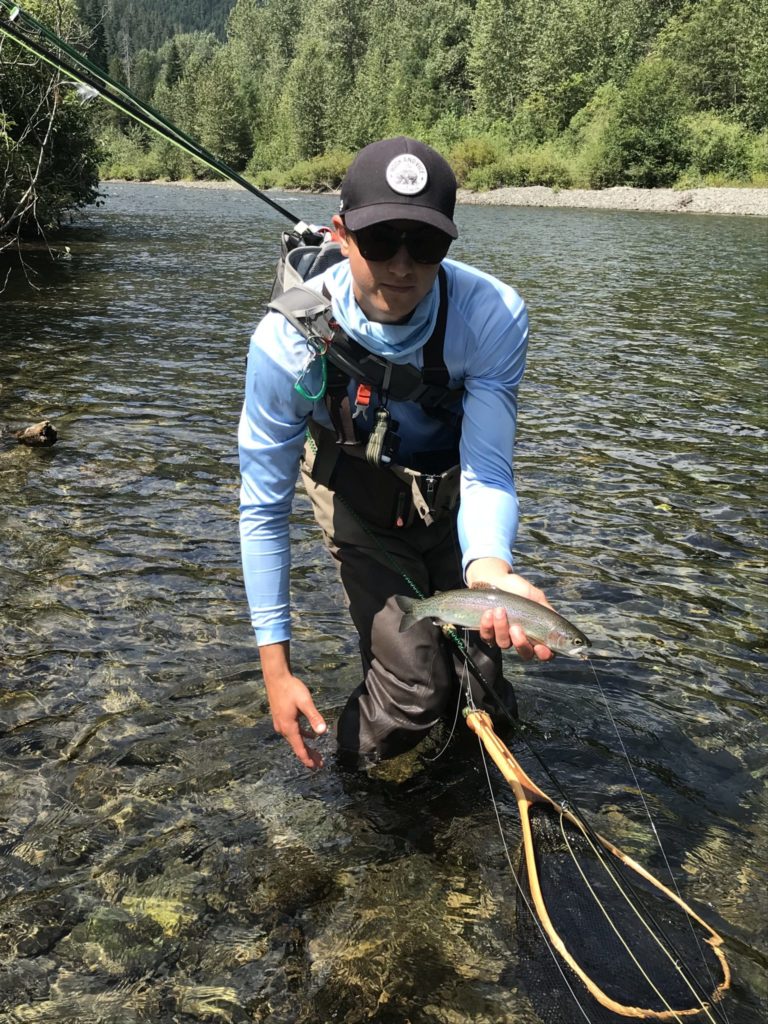
On the bull trout front there are definitely a lot more bulls in the river now. Swinging an all-white 2-4-inch streamer is my go-to and has produced many fish for me. I will typically start with that when I get into a run that I can see bull trout in. If that doesn’t work a smaller sculpin style fly like a sculpzilla or olive slumpbuster should do the trick. The sculpin might even tempt some eager rainbows sitting in the run as well.
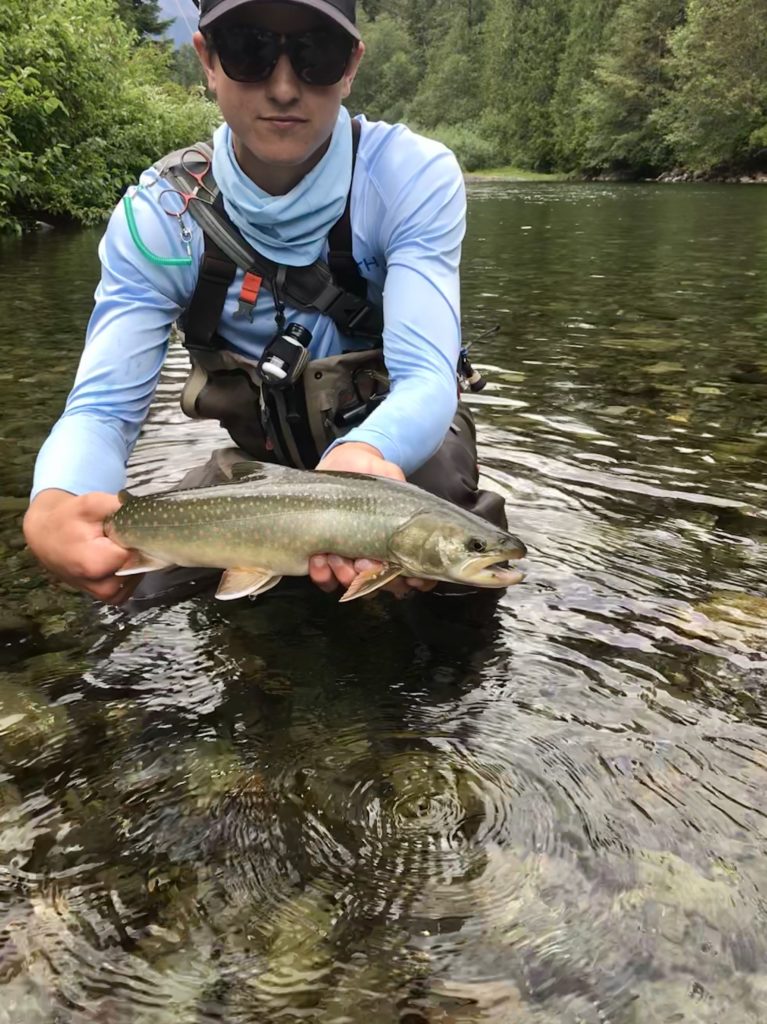
On another note, the road is in great condition this year. However, some people seem to be taking that to their advantage by getting to their fishing spots quite quickly. I have already seen two cars in trees/banks this year so please watch you speed around corners and on the road in general.
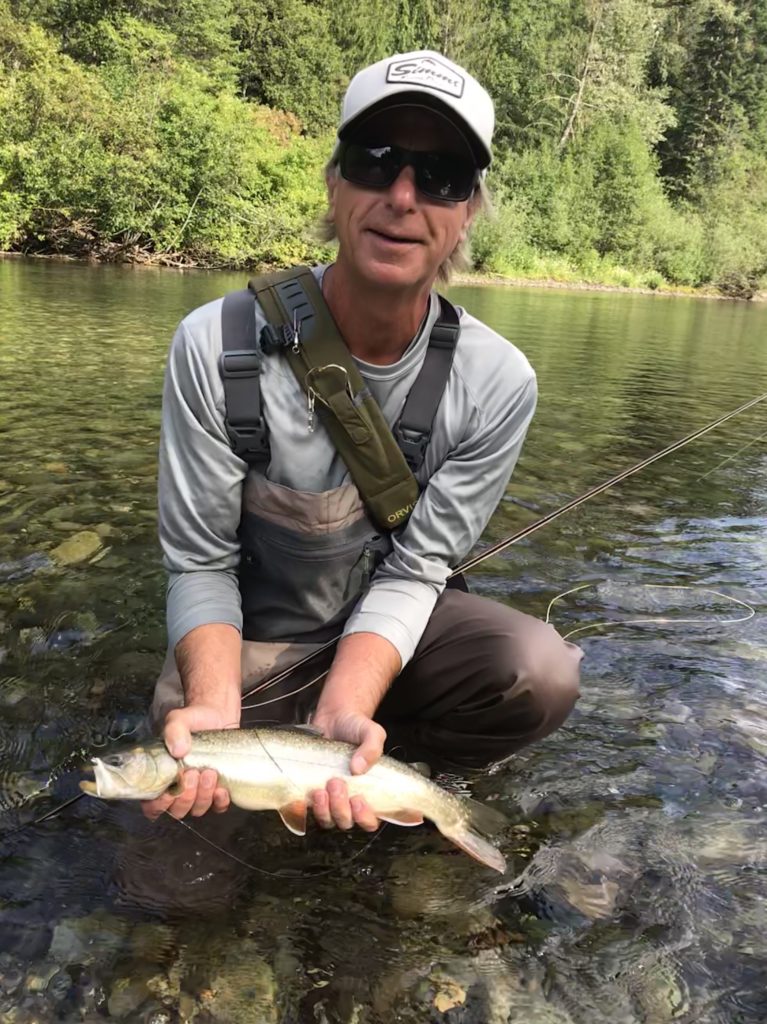
Best of luck out there, and remember your bug spray,
Brendan Guraliuk
STILLWATER FISHING REPORT
Interior Lakes Fishing Report
Light cloud cover with scorching heat is on the menu for your favourite interior lakes. It’s looking to be well over 30 degrees for the next week or so.
This gives additional emphasis on both the when and the where of your spot. Try to maximize your time at first and last light, matching any mayfly, damsel, or dragonfly hatch that may show up throughout.
That’s the when, but the where is even more important. The way I see it, you’ve got two options. You can either head up to some of the higher elevation lakes we’ve been talking about for the last week, namely Roche and Hatheume, as they have an extended season compared to their low elevation counterparts, but still slow down as August rolls through. But if you’re willing to go a little further for a weekend trip, consider areas like 100 Mile House and Williams Lake. The fishing in lakes around there tend to stay strong throughout the summer, I’ve even caught some lunkers in the dead heat of mid-august. For these lakes, revert your techniques to about a month and a half to when you were fishing in mid-June. Fish damsel and mayfly nymphs along with stripped and balanced leeches. Keep a throat pump at the ready if you see signs of a chironomid hatch as well.
It’s a long trek, but you will be rewarded with some fantastic angling.
Fish long and prosper.
Aidan Munro
SALTWATER FISHING REPORT
Vancouver Saltwater Salmon Fishing Report
Well we made it! August is now here, and most of our restrictions have now been lifted! Be sure you’re up to date with various regulations by checking out all fishing notifications here. They have made numerous amendments and clarifications so its worth checking the link and reading through all related regulations.
We had to deal with some fairly significant Northwest and Westerly winds, which forced us to take shelter in Howe Sound. We had boats that fished both Cowan/Seymour Bay as well as Hole in the Wall. Most days we were hooking Chinook, Coho, and Pinks. Productive Depths at Cowan have been 70-130 with spoons, hootchies or anchovies.
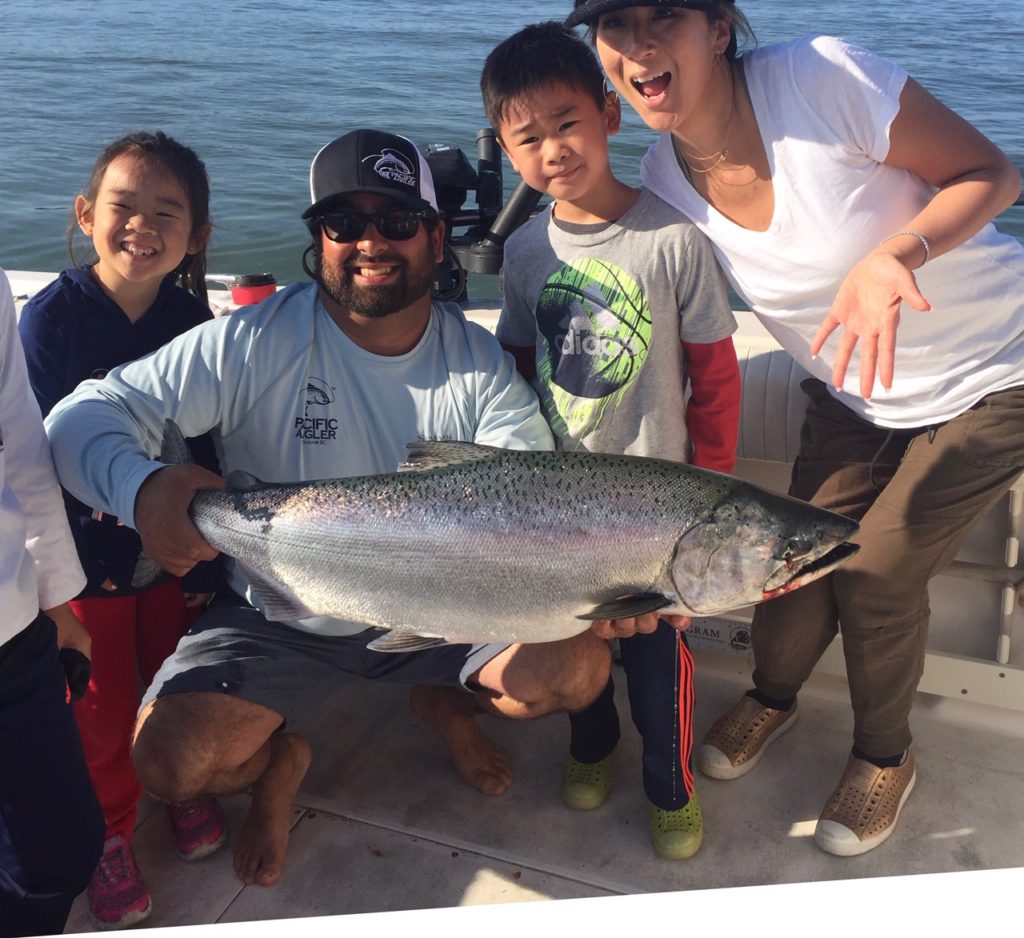
When we were able to, our efforts have been concentrated at the Bell Buoy. The larger, mature Fraser River fish have been hanging around, and most tides have been producing quality fish. For our guides, the action has been quite sporadic. It is not uncommon to go a couple hours without a bite, and then get a few in a short period of time. We hope that once we get through these big tides and strong currents that things will continue to pick up. Most fish are being picked up quite shallow on the downrigger, with 30-60 feet being the most productive. We have been running mostly 5.5 or 6.0-inch anchovies in a Rhys Davis teaser head. Chrome and UV finishes on your shallow rods and glow finishes on your deepest rods. The Betsy flasher with a purple chrome teaser head has been a top producer all week. Now that parts of Area 29 are open, we will start to fish outside of the Bell Buoy and see what is going on down towards the North Arm and T10. We will report back next week!
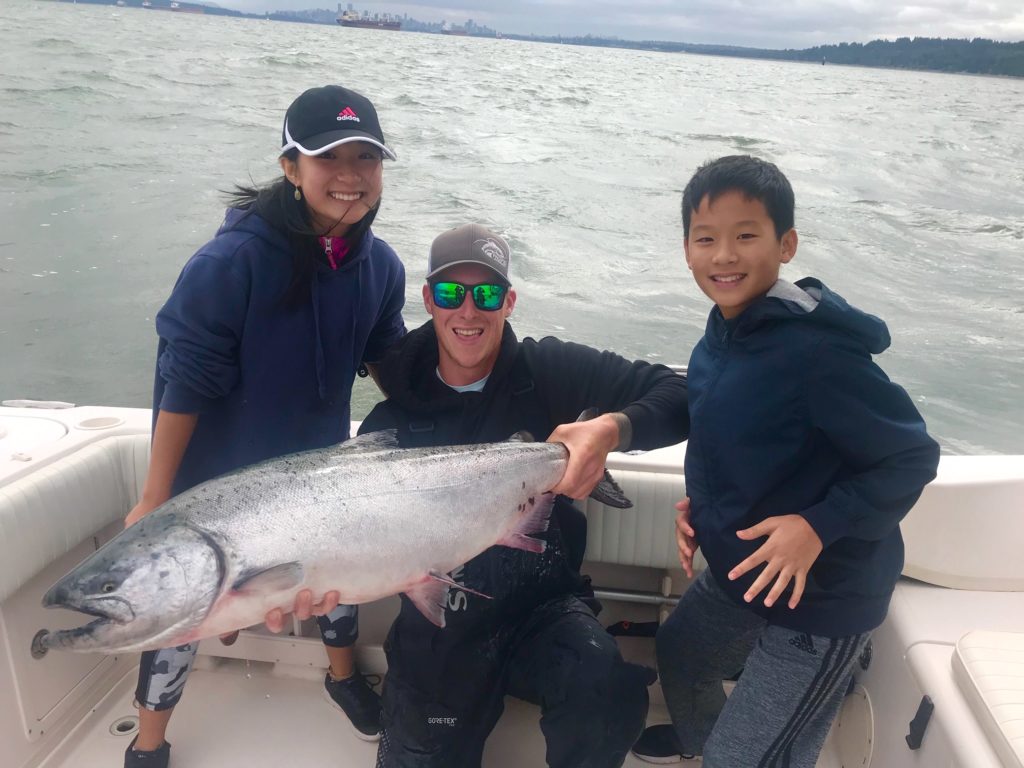
Because of the wind, and the nature of our trips this week we haven’t had any boats over in the Gulf Islands. The reports we have been hearing are thing have slowed a little since mid July, but there are still nice fish to be had if you put your time in. As usual, most of the fish off of Gabriola and Entrance are being hooked down deeper from 150-250 feet on the down rigger. The Yamashita Blue Splatter Back has been a go to over there.
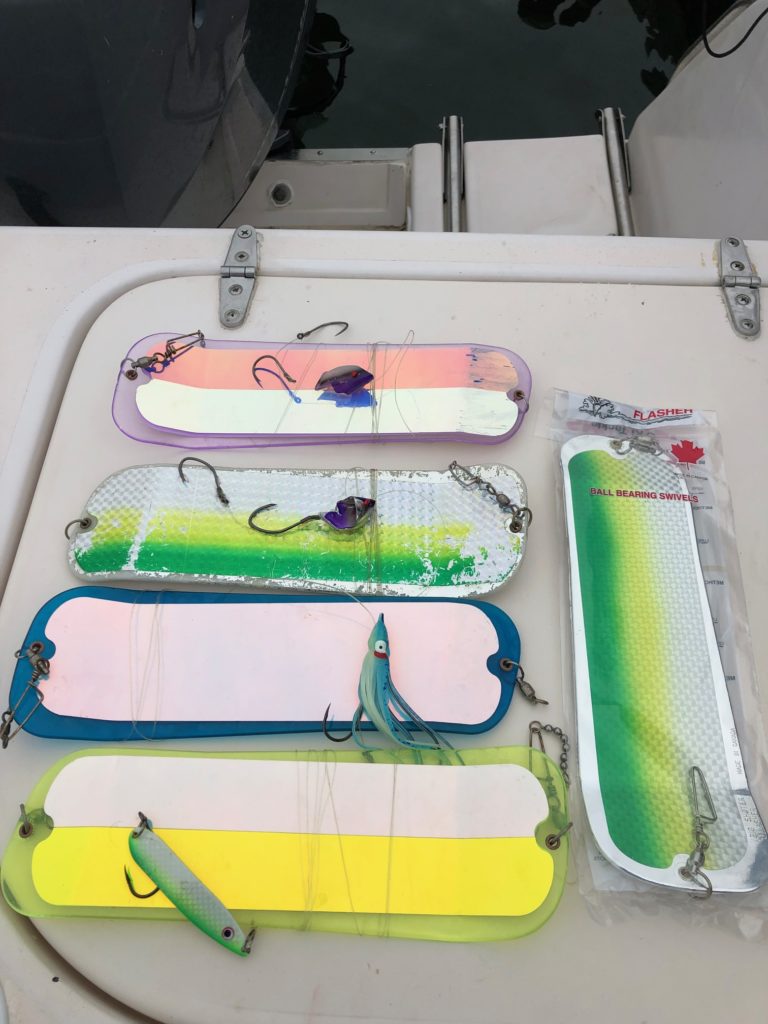
We are super excited about the upcoming weeks as we start to see more of these Fraser Chinook make their push for the river. Get out there and see what’s going on for yourself, or give us a call as we still have a few dates left for August!
Derek Puri
Sunshine Coast Saltwater Special
In a recent trip this past weekend I ventured up to the Sunshine Coast to do a little fishing. For those of you that have summer cabins in that area, or on surrounding islands, or are looking to plan a summer getaway up that way, there are many different fishing opportunities available. I was fortunate enough to be fishing from a boat and explored all the possibilities the coast had to offer.
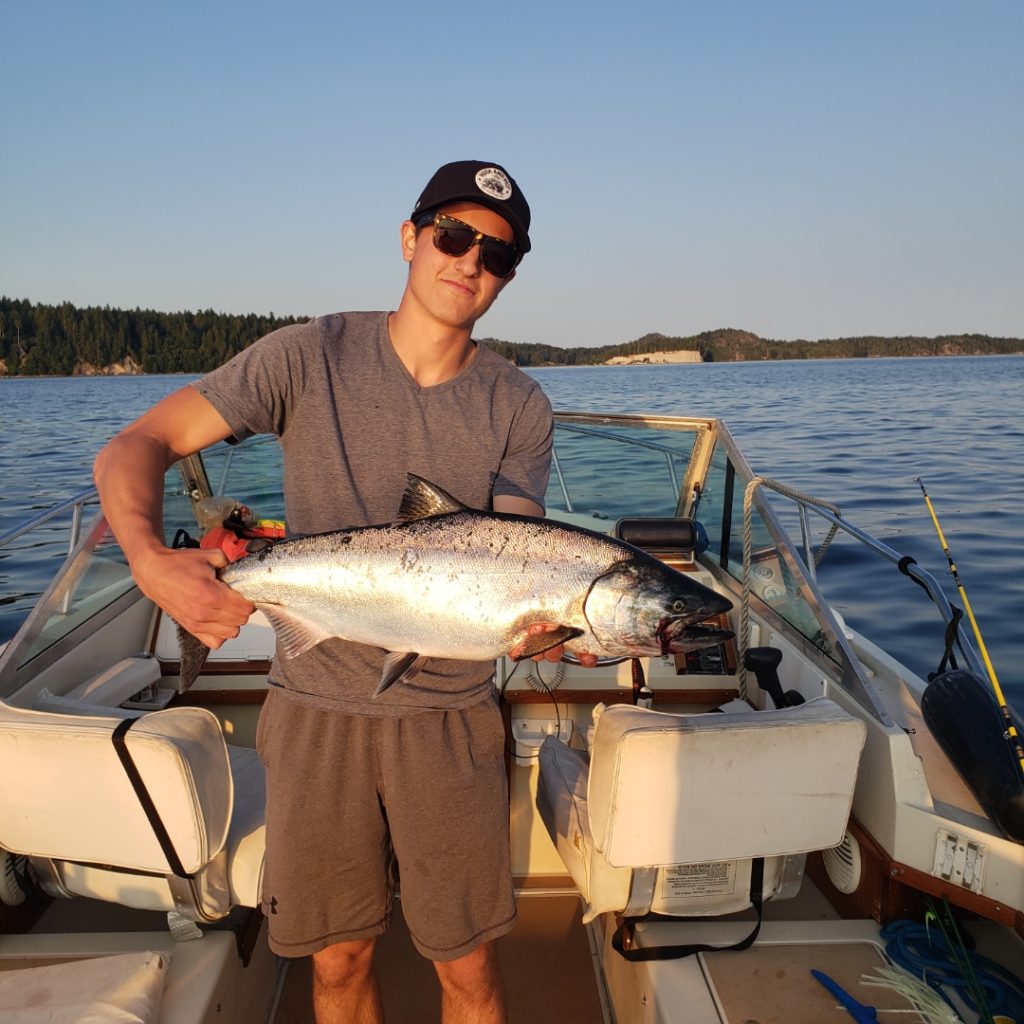
If you want to target salmon, trolling with downriggers is key. I fished Epsom point for Chinook and had success fishing glow spoons anywhere from 60-110 feet on the riggers. Texada island is more of your classic West Van shoreline Coho fishery. Fishing along shallow contour lines with white hootchies and 3” UV spoons seemed to work best and produced many Coho. For those of you who don’t have downriggers, jigging buzzbombs through a bait-ball when you can find one was another productive method that produced a few fish.
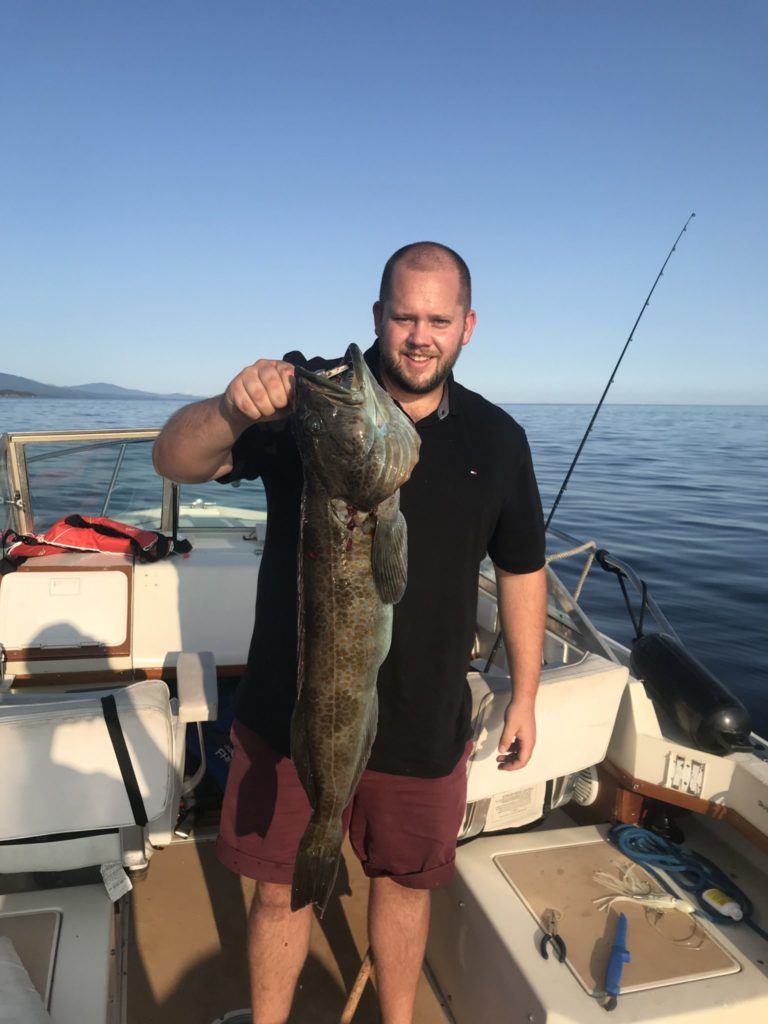
Bottom fishing is both easily accessible and can be super productive and fun when salmon fishing isn’t the greatest. Fishing off rocky outcroppings with both buzzbombs and swimbaits can elicit many bites from species of rockfish as well as lingcod. This fishery can also be accessed by those who don’t have the luxury of owning a boat. Fishing the previously mentioned lures from shore, kayak, or a super Vancouver paddleboard can be effective and fun for kids. Just remember when fishing for bottom fish it is mandatory now to have a descending device on the boat ready to go.
If you have any questions about fishing this area don’t hesitate to call or ask in the shop.
Best of luck out there,
Brendan


